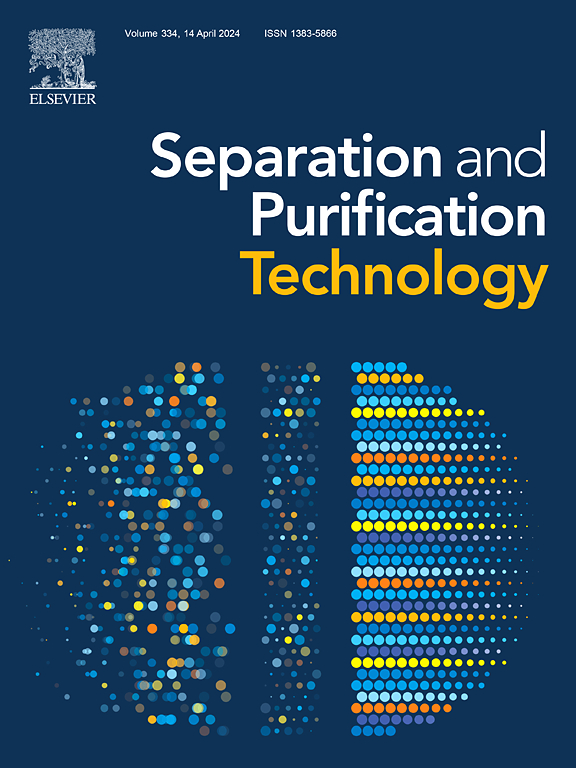Mechanism of Z-scheme BN/BiOI heterojunction for efficient photodegradation of perfluorooctane sulfonate (PFOS)
IF 9
1区 工程技术
Q1 ENGINEERING, CHEMICAL
引用次数: 0
Abstract
Perfluorooctane sulfonate (PFOS) poses a significant threat to human health and ecosystems throughout its lifecycle because of its PBT-LRT properties. In this study, a Z-scheme photocatalyst BN/BiOI was developed and evaluated for its efficacy in photodegrading PFOS. Notably, after 2 h of reaction, 100 % removal of PFOS (kobs = 1.278 h−1) was achieved, alongside a 100 % desulfurization rate and a 45.40 % defluorination rate after 6 h. Comparing the BN/BiOI system to BN, the remarkable enhancement observed in BN/BiOI heterojunction can be attributed primarily to the efficient separation and reduced recombination rate of photogenerated electrons and holes. Insights from Electron Paramagnetic Resonance (EPR) analysis shed light on the roles of e-, h+, •OH, and •O2H radicals in the PFOS degradation process facilitated by BN/BiOI. The proposed mechanism for photocatalytic PFOS degradation by the BN/BiOI system underscores the initial breaking of the C-S bond. Moreover, BN/BiOI showcases its effectiveness in degrading perfluorocarboxylic acids (PFOA, TA, C7, and Gen-X) as well as perfluoro sulfonic acids (F-53B, F-53, and 6:2 FTS), highlighting its potential for treating not only PFOS but also other PFAS contaminants across a broad pH range. To the best of our knowledge, this study is the first to demonstrate the Z-scheme BN/BiOI heterogeneous photocatalytic degradation of PFOS.
z-scheme BN/BiOI异质结高效光降解全氟辛烷磺酸的机理
全氟辛烷磺酸(PFOS)由于其PBT-LRT特性,在其整个生命周期中对人类健康和生态系统构成重大威胁。本研究开发了一种Z-Scheme光催化剂BN/BiOI,并对其光降解全氟辛烷磺酸的效果进行了评价。值得注意的是,反应2 h后,PFOS去除率达到100% % (kobs = 1.278 h−1),6 h后脱硫率为100% %,除氟率为45.40% %。将BN/BiOI体系与BN相比较,BN/BiOI异质结的显著增强主要归因于光电子和空穴的有效分离和降低的复合速率。电子顺磁共振(EPR)分析揭示了e-、h+、•OH和•O2H自由基在BN/BiOI促进全氟辛烷磺酸降解过程中的作用。提出的BN/BiOI系统光催化降解全氟辛烷磺酸的机制强调了C-S键的初始断裂。此外,BN/BiOI展示了其在降解全氟羧酸(PFOA、TA、C7和Gen-X)以及全氟磺酸(F-53B、F-53和6:2 FTS)方面的有效性,突出了其不仅可以处理全氟辛烷磺酸,还可以处理广泛pH范围内的其他全氟辛烷磺酸污染物。据我们所知,这项研究首次证明了Z-scheme BN/BiOI非均相光催化降解全氟辛烷磺酸。
本文章由计算机程序翻译,如有差异,请以英文原文为准。
求助全文
约1分钟内获得全文
求助全文
来源期刊

Separation and Purification Technology
工程技术-工程:化工
CiteScore
14.00
自引率
12.80%
发文量
2347
审稿时长
43 days
期刊介绍:
Separation and Purification Technology is a premier journal committed to sharing innovative methods for separation and purification in chemical and environmental engineering, encompassing both homogeneous solutions and heterogeneous mixtures. Our scope includes the separation and/or purification of liquids, vapors, and gases, as well as carbon capture and separation techniques. However, it's important to note that methods solely intended for analytical purposes are not within the scope of the journal. Additionally, disciplines such as soil science, polymer science, and metallurgy fall outside the purview of Separation and Purification Technology. Join us in advancing the field of separation and purification methods for sustainable solutions in chemical and environmental engineering.
 求助内容:
求助内容: 应助结果提醒方式:
应助结果提醒方式:


